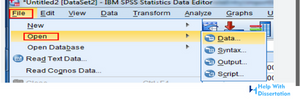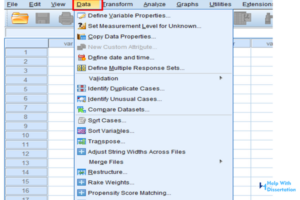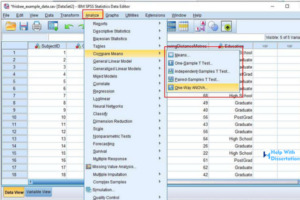Dissertation Data Analysis Help Tailored To Meet Your Dissertation Objectives

At help with dissertation, we believe you should seek professional dissertation data analysis help from the first stage of writing the dissertation. You may ask why it is necessary to engage our dissertation data analysts. Data analysis is not an afterthought in writing a dissertation, research paper, thesis or action research paper. When formulating research hypothesis and questions, you should have in mind data analysis procedures in mind. A professional SPSS data analysis service will guide you in developing research objectives, hypothesis and questions that can supported by the most appropriate data.
Moreover, dissertation committees critically evaluate the way results have been analyzed and presented. Therefore, your dissertation can be rendered useless if major flaws are detected in your analysis. To avoid such embarrassing moments, you need to seek dissertation data analysis help form our data analysis experts for dissertations, thesis and research paper.
What is Data Analysis?
Did you know data analysis is torturing data to reveal vital information? In present world, organizations are building their future on data. All industry players, from insurance, banking, hospitality, agriculture and manufacturing are turning to data for valuable information to gain competitive advantage over their peers. Aided by advanced computing power and databases, it is possible to collect and collate large amounts of data. However, without data analysis, raw data is no use. Data analysis plays a key role in extracting valuable information from the data. Data analysis uses analytic methods both logical and statistical to draw inferences and predict the future. This systematic procedure also applies when writing a dissertation or thesis or capstone project.
Data analysis is majorly segmented into two core areas.
- Quantitative methods: It is numerical based data obtained through surveys. It is objective and utilizes primary deductive process to test hypothesis. Data analysis is through statistical tests
- Qualitative methods: It is text based data obtained through focus groups and interviews. It is subjective and requires no statistical techniques. Data analysis is through matching of themes
Our data analysis help is tailored to assist you extract as much information as possible from your research data. Our dissertation statistical consultants are conversant with both quantitative and qualitative methods of data analysis.
Data Analysis Plan for Dissertation
Are you looking for dissertation data analysis help? Then you must know how to write a data analysis plan for your dissertation data. However, if you are unable to develop a solid data analysis plan, you can always talk to our data analysis help service for assistance.
What is a data analysis plan? It is a roadmap detailing how data collected will be stored, cleaned transformed and thereafter analyzed. A good data analysis plan contains the following aspects
- States research objectives and hypothesis
- Discusses the dataset collected
- Provides inclusion and exclusion criteria
- Outlines the research variables (Independent, dependent, confounding, covariates variables)
- Clearly states data cleaning and transformation process
- Identifies statistical software and tests to be carried out
- Producing shell tables
Why is Data Analysis Important in Academic Projects?
Just like how data analysis plays a major role in providing powerful insights for businesses and governments, data analysis assists scholars and researchers gain new insights. For instance, a student writing DNP project on how determine effectiveness of an improved clinical practice on patients will use data analysis to understand if any changes in patient response to treatment is due to chance or efficacy of the practice. Therefore, students undertaking academic research project will need data analysis help to render their results valid and scientifically accepted.
Three major steps to be followed when writing quantitative dissertation
There are three major steps involved during data analysis process. This includes:
- Choosing the most suitable statistical tests depending on the type of data collected
- Preparation, data cleaning, validation and analyzing data using suitable statistical program such as R, SPSS, Stata or MS-Excel
- Interpreting statistical findings and writing the results
Though the steps may seem easy and straightforward, they are daunting for disastrous, more so to students that lack sound quantitative background. Our data analysis help will hold your hand through the three steps of data analysis process.
How to Analyze Quantitative Data for Dissertation
Data analysis is the heart of any research project or dissertation. It’s all about taking data and transforming it into insights. But how do you do that?
Quantitative data is described as data obtained through counting or measuring in numerical values and represented by numerical variables. An advantage of quantitative data is that it can be verified or replicated in research outcomes. Statistics offers necessary tools to turn quantitative data into insights. Our dissertation data analysis help follows the following five step approach to analyze quantitative data.
Step 1: Plan your research design and hypotheses
First up, know what you want to find out and how you’ll do it. Jot down your research question and hypotheses in a testable manner. For example:
- Research question: Can meditation help teens ace exams?
- Null hypothesis: No difference in math scores with a 5-min meditation exercise.
- Alternative hypothesis: Better math scores with a 5-min meditation exercise.
Then, plan your research design, considering:
- Type of research: Is your research quantitative or qualitative? Quantitative research involves measuring variables using numbers, while qualitative research involves exploring meanings and experiences using words.
- Sampling method: How will you select your participants or cases? You should use a sampling method that is appropriate for your research question and population. You can, for example, utilize random sample, stratified sampling, convenience sampling, and so on.
- Data collection method: How will you collect your data? You should use a data collection method that is reliable and valid for your research question and variables. For instance, you can use surveys, experiments, interviews, observations, etc.
- Data analysis method: How will you analyze your data? You should use a data analysis method that is suitable for your research question and data type. You may, for instance, make use of descriptive statistics, correlation, regression, t-test, ANOVA, etc.
Step 2: Gather data from a sample
Now that you’ve got a plan, collect data from a sample representing your target group. Just remember, follow ethical guidelines and ensure your data’s accuracy.
Step 3: Summarize with descriptive statistics
Got your data? Time to organize and summarize with descriptive stats! Use mean, median, mode, standard deviation, frequency, distribution, etc., to grasp your sample’s key features and spot errors or outliers.
Step 4: Test hypotheses with inferential statistics
Here’s where the magic happens! Use inferential stats to test your hypotheses or make estimates. Draw conclusions and assess their significance with confidence.
For example, if you want to test whether meditation has an effect on math test scores in teenagers, you can use a t-test to compare the mean scores of two groups: one that received a 5-minute meditation exercise before the test and one that did not. The t-test will tell you if there is a statistically significant difference between the two groups.
Step 5: Interpret your results
Finally, it’s time to interpret your findings. Discuss their implications and compare them to previous literature. Don’t forget to point out limitations and suggest future research directions.
So, if meditation positively impacts math scores, you can conclude it’s a helpful technique for teens’ academic performance. Compare your findings with similar studies, mention factors that may have influenced your results, and propose further research ideas.
And there you have it! You’re all set to write an awesome data analysis section for your research paper.
Most Common Statistical Tests Utilized In Our Data Analysis Help
Most dissertations and thesis rely on quantitative data analysis to analyze data and test hypothesis. Below is a list of the common statistical tests that our dissertation data analysis help utilize:
- T-Test: The statistical test is used to determine if the means of two groups are different with unknown variances. The t-statistic follows students t-distribution
- Regression: This is a statistical measure to determine relationship between one dependent variable and a set of independent variables
- Z-test: This is a statistical test that is used to determine whether two populations means are different when variances are known and the sample size is large (greater than 30). The z-statistic follows normal distribution.
- Chi-square: a statistical test to compare relationship or association between categorical variables. The test statistic follows chi-square distribution
- Correlation: This is a statistical measure that determines the strength of liner relationship between two variables
7 Steps of Data Analysis To Be Followed By Our Dissertation Data Analysts
When turning data into actionable information, our data analysts follow seven steps to complete the data analysis process.
- Defining research objective: Our data analysts starts by defining the research objective of the study.
- Data collection: the second step is sourcing and collecting data. Data should be relevant to support solution to stated research objective. Data sources include surveys, databases or buying data from third party sources
- Data cleaning: This stage involves data processing, transformation and verification. Our data analysts will look for errors, missing data and outliers. We will then fix the data ready for data analysis.
- Performing exploratory data analysis: Both simple and advanced statistical methods are performed on the data to reveal patterns and hidden relationships. Our statisticians have deep statistical knowledge to determine the most suited test to utilize
- Building and testing models: During this step our data analysts put together and tested statistical models for better accuracy.
- Model deployment: This stage involves deploying the statistical or machine learning model to produce output.
- Monitoring and validating model against objectives: During this phase, results are monitored and validated against expected results.
Hire Dissertation Data Analysts Today For Professional Data Analysis Help

We start by reviewing your research objectives, questions and hypothesis to ensure that they are compatible with the data and will fully provide statistically sound results. We will then review your dissertation methodology section to ensure that the research strategy adopted is compatible with the study’s objectives and will have minimal statistical errors. When writing dissertation methodology section it is important to seek dissertation data analysis help more so if the study is quantitative. In this chapter you’re required to highlight the data analysis approach you intend to use to achieve the research aims. Remember that statistical analysis methods are not chosen haphazardly but are backed by sound statistical reasoning.
Our SPSS dissertation data analysis service will take you through the entire analysis cycle that includes:
- Testing for consistency of data collection instruments
- Reviewing the data
- Data cleaning and validation
- Identifying most appropriate statistical software and tests
- Testing for statistical assumptions of the data
- Statistical data analysis
- Interpretation of results and findings
- Drawing conclusions from the findings
In case we find any mistakes we will gladly guide you and revise your work to ensure it meets the appropriate conditions. Moreover, we will offer you continued support until your dissertation has been accepted by the committee.
How Can Our SPSS Data Analysis Service For Dissertation Assist You

However the most user friendly and commonly used data analysis software for dissertation is SPSS. The program can perform both simple and highly complex statistical analysis with minimal or no coding, making it appropriate for statistical analysis for dissertations, research papers, thesis and capstone project.
Our dissertation data analysis help include conducting statistical tests for univariate, bivariate and multivariate data. We are experts in the following statistical methods
- Chi-square and T-tests
- ANOVA, ANCOVA and MANOVA
- Repeated measures ANOVA
- Factor and cluster analysis
- Survival models and analysis
- Bayesian theory and analysis
- Game theory
- Statistical quality control tests
- Power analysis
- Non Parametric tests
- Non-linear regression
- Multiple and logistic regression
Due to the wide application of statistics in diverse fields, our professional SPSS data analysis services are used by students writing dissertations in psychology, nursing, marketing, GIS, agriculture, IT among others.
How to Use SPSS to Analyze Dissertation Data: A Step-by-Step Guide
Imagine you’re a student working on your capstone project or dissertation. You’ve gathered a lot of data, but now you’re stuck on how to analyze it. It can be overwhelming and confusing, but fear not! This article will guide you through the process of using SPSS (Statistical Package for the Social Sciences) to analyze your dissertation data.
From here on out, we’ll be taking a journey together to learn how to use SPSS to analyze your dissertation data. Whether you’re a beginner or an advanced user, we’ve got you covered. So, sit tight, grab your favorite beverage, and let’s dive in!
Step #1: Importing Your Data to SPSS
The first step in using SPSS to analyze your dissertation data is importing it into the software. To do this, you’ll need to have your data in a compatible format, such as an Excel or CSV file.
To import your data into SPSS, select “File” from the menu bar and then “Open.” Browse to your data file and select it. You’ll then see a window with various import options. Ensure that you select the correct options for your data, such as delimiter settings and variable types.

How to import data to SPSS: First you will click file then select open and click it. It will open a dialogue box from which you can select your data file.
Step #2: Cleaning Your Data
Once you’ve imported your data, you’ll want to clean it up by removing any errors or inconsistencies. This process is essential to ensure that your results are accurate and reliable.
To clean your data in SPSS, you’ll want to use tools such as “Sort Cases” and “Select Cases” to filter out any problematic data points. You can also use the “Recode” function to transform your data into a more usable format.

How to clean data using SPSS. In this SPSS operation you can transpose, recode, merge or sort data to usable format
Step #3: Running Descriptive Statistics
With your data imported and cleaned, you’re now ready to start running statistical analyses. The first step in this process is to generate descriptive statistics for your variables.
To do this in SPSS, select “Analyze” from the menu bar and then “Descriptive Statistics.” From here, you can select the variables you want to analyze and choose which descriptive statistics you want to calculate, such as means, standard deviations, and ranges.

How to generate descriptive statistics: To do this in SPSS, click “Analyze” from the menu bar and then “Descriptive Statistics. Select the variables you want to analyze and choose which descriptive statistics you want to calculate, such as means, standard deviations, and ranges
Step #4: Running Inferential Statistics
With your descriptive statistics in hand, you can now move on to running inferential statistics. These types of analyses allow you to draw conclusions about your data and test hypotheses.
To run inferential statistics in SPSS, you’ll want to select “Analyze” from the menu bar and then choose the appropriate statistical test for your data. Common examples include t-tests, ANOVA, and regression analysis.

How to generate inferential statistics: To do this in SPSS, Click “Analyze” from the menu bar and then choose the appropriate statistical test for your analysis.
Step #5: Interpreting Your Results
Once you’ve run your statistical analyses, you’ll need to interpret your results to make sense of your data. This process can be challenging, especially for beginners, but it’s essential to ensure that your conclusions are accurate.
To interpret your results in SPSS, you’ll want to review the output generated by the software. This output includes tables, graphs, and other visual aids that can help you understand your data better. You may also want to consult with your supervisor or a statistical expert to help you interpret your results correctly.
And Finally!
Analyzing dissertation data using SPSS may seem daunting at first, but with the right guidance, it’s a manageable task. You’ll be well on your way to generating accurate and reliable results for your dissertation or capstone project. Remember to keep your data clean and well-organized, choose the appropriate statistical tests, and interpret your results carefully. You can hire our dissertation data analysis help for detailed analysis and writing assistance of results and finding chapter.
By seeking dissertation data analysis help from help with dissertation you will have less stress and anxiety when facing the dissertation committee. With our high quality statistical analysis for dissertation you will face few criticism and rewrites from the committee, making your dissertation writing a success.
